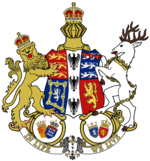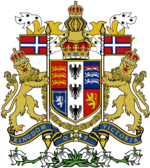Royal coat of arms of the Victorian Empire
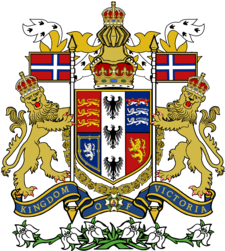
| |
| Versions | |
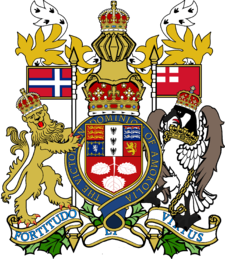
| |
| Royal coat of arms as used in Amokolia
| |
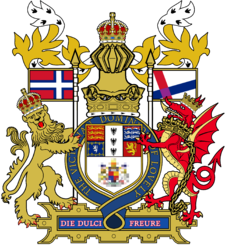
| |
| Royal coat of arms as used in Lovely
| |
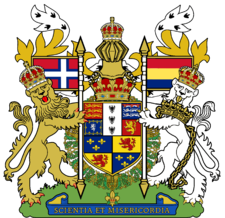
| |
| Royal coat of arms as used in Valencia
| |
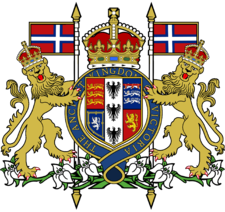
| |
| The coat of arms used by the Victorian Government
| |
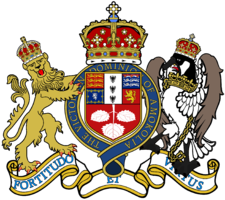
| |
| The coat of arms used by the Amokolia Office
| |
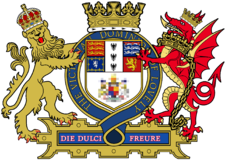
| |
| The coat of arms used by the Lovely Office
| |
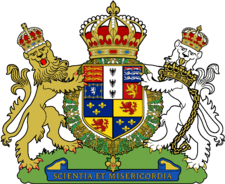
| |
| The coat of arms used by the Valencia Office
| |
| Details | |
| Armiger | Victoria II |
| Adopted | |
| -Amokolia | 2009 |
| -Lovely | 2010 |
| -Valencia | 2009 |
| -Victoria | 1910 |
| Motto | |
| -Amokolia | Fortitudo et Virtus |
| -Lovely | Die Dulci Freure |
| -Valencia | Scientia et Misericordia |
| Orders | |
| -Valencia | Order of the Valencian Star |
| -Victoria | Order of Saint Andrew |
| Use | On all Acts of Law; the cover of all Imperial passports; various government departments. |
| Earlier use | See below |
|} The Royal Coat of Arms of the Victorian Empire is the official coat of arms of the Victorian monarch, currently Queen Victoria II. These arms are used by the Queen in her official capacity as monarch of the Victorian Empire, and are officially known as her Arms of Dominion. Variants of the Royal Arms are used by other members of the Royal Family; and by the Governments in Victoria in connection with the administration and government of the Kingdom. In Amokolia, Lovely and Valencia the Queen has a separate version of the Royal Arms, variants of which are used by the Amokolia Office, Lovely Office and the Valencia Office.
The shield is quartered, depicting in the first quater the three passant guardant lions of Abbervale; in the second quater, the three passant guardant lions of Dundas; in the third quater, the rampant lion and double tressure fleury-counter-fleury of Moncrieff; and in the fourth, the lion rampant of Strathalmond. Over all this is a pale, broad vertical strip, with three black eagles representing the importance and history of Adraisia. This heraldic design has remained the same since the Declaration of Alnwick brought these five former Kingdoms into the Unified Kingdoms of Victoria in 1891.
The crest is a royal helmet upon the crown of victoria wearing the imperial crown, representing the importance and authority of the Victorian Empire above all else.
The dexter supporter is an Imperial lion wearing the Imperial crown; the sinister, a Victorian lion is wearing the crown of victoria, denoting the mother country of the Empire. Both are holding a lance Argent, point Or, flying therefrom to the dexter and sinister the State Flag of the Kingdom of Victoria.
The coat features the Order of Saint Andrew behind the shield. The Valencian variation shows the Order of the Valencian Star.
The compartment depicts a wreath of White Lillies, the national flower of the Kingdom of Victoria. This emphisises the importance and role of Victoria within the Empire.
The shield design forms the Royal Standard of Victoria. Variations are also used on the Standards of other members of the Victorian Royal Family.
Uses
The Royal Arms as shown above may only be used by the Queen herself. They also appear in court rooms, since the monarch is the fount of justice in the Empire and the High Court is part of the Court of the monarch. Judges are officially representatives of the crown, demonstrated by the Queen's Coat of Arms which sits behind the judge on the wall of every court in the land.
The Victorian Government also uses the Royal Coat of Arms as a national symbol of the Kingdom of Victoria, and, in that capacity, the Coat of Arms can be seen on several government documents and forms, passports, in the entrance to embassies and consulates, etc. However, when used by the government and not by the sovereign herself, the coat of arms is often represented without the helm. This is also the case with the sovereign's Amokolian, Lovelian and Valencian arms, versions of which are used by the various dominion offices.
The Queen awards Royal Warrants to various businesses that supply the Royal Household. This allows the business to display the Royal Arms on their packaging and stationery.
A banner of the arms, the Royal Standard is flown from the Royal Palaces when the Queen is in residence; and from public buildings only when the Queen is present. At royal residences such as Riego Palace, the Queen's main residence, the Royal Standard is flown to indicate when the monarch is in residence. This protocol equally applies to the monarch's principal residences in Amokolia, Lovely and Valencia, where the Royal Standard as used in these countries is flown. When the monarch is not in residence the State Flag of Victoria is flown, regardless of which country it may be in.
Royal Variations
Amokolia
The shield is tierced in fesse the first division containing the quarterly coat following, namely, three passant guardant lions of Abbervale and the rampant lion and double tressure fleury-counter-fleury of Moncrieff. The second division is a pale, broad vertical strip, with three black eagles of Adraisia. The third division contains the three passant guardant lions of Dundas and the lion rampant of Strathalmond. The fourth division depicts three oak leaves conjoined on one stem proper, this represents the national tree of Amokolia, the oak tree.
The crest is a royal helmet upon the crown of Amokolia wearing the Imperial crown, representing the importance and authority of the Victorian Empire above all else.
The dexter supporter is an Imperial lion, crowned with the Imperial crown, holding a lance Argent, point Or, flying therefrom to the dexter the State Flag of Victoria; the sinister, a Canadian Goose, wearing the crown of Amokolia and holding a lance Argent, point Or, flying therefrom to the dexter the historical Flag of Amokolia. According to officials within Victoria a free Amokolia is considered a very unstable entity; therefore the heraldic goose is chained.
The coat features a banner, representing the Order of Saint Andrew behind the shield with the words The Victorian Dominion of Amokolia.
The compartment depicts a wreath of Oak Leaves, depicting the national tree of Amokolia and the vast natural lands upon which Amokolia is based.
The motto Fortitudo et Virtus meaning Courage and Virtue is shown upon a white banner of peace with the font in blue representing the stretch of sea that splits the province of Automatica with the rest of the country.
The shield design forms the Royal Standard of Amokolia.
Lovely
The shield is tierced in fesse the first division containing the quarterly coat following, namely, three passant guardant lions of Abbervale and the rampant lion and double tressure fleury-counter-fleury of Moncrieff. The second division is a pale, broad vertical strip, with three black eagles of Adraisia. The third division contains the three passant guardant lions of Dundas and the lion rampant of Strathalmond. The fourth division depicts the historical coat of arms of the Kingdom of Lovely upon a white background.
The crest is a royal helmet upon the crown of Lovely wearing the Imperial crown, representing the importance and authority of the Victorian Empire above all else.
The dexter supporter is an Imperial lion, crowned with the Imperial crown, holding a lance Argent, point Or, flying therefrom to the dexter the State Flag of Victoria; the sinister, a Lovelian Dragon, wearing the crown of Lovely and holding a lance Argent, point Or, flying therefrom to the dexter the historical Flag of Lovely. According to officials within Victoria a free Lovely is considered a very unstable entity; therefore the heraldic dragon is chained.
The coat features a banner, representing the Order of Saint Andrew behind the shield with the words The Victorian Dominion of Lovely.
The motto Die Dulci Freure meaning Have a Nice Day is shown upon a metal banner.
The shield design forms the Royal Standard of Lovely.
Valencia
The shield is tierced in fesse the first division containing the quarterly coat following, namely, three passant guardant lions of Abbervale and the rampant lion and double tressure fleury-counter-fleury of Moncrieff. The second division is a pale, broad vertical strip, with three black eagles of Adraisia. The third division contains the three passant guardant lions of Dundas and the lion rampant of Strathalmond. The fourth division the quarterly coat containing in the first and fourth quaters three yellow fleur-de-lies on a blue background; the second and third quaters the red rampant lion on a yellow background.
The crest is a royal helmet upon the crown of Valencia wearing the Imperial crown, representing the importance and authority of the Victorian Empire above all else.
The dexter supporter is an Imperial lion, crowned with the Imperial crown, holding a lance Argent, point Or, flying therefrom to the dexter the State Flag of Victoria; the sinister, a white Valencian Lion, wearing the crown of Valencia and holding a lance Argent, point Or, flying therefrom to the dexter the historical Flag of Valencia. According to officials within Victoria a free Valencia is considered a very unstable entity; therefore the heraldic white lion is chained.
The coat features the Order of the Valencian Star behind the shield.
The compartment is that of fresh, untouched lands, this depicts the hope that Valencia is given by a fresh start under the Empire.
The motto Scientia et Misericordia meaning Knowledge and Compassion is shown upon a Victorian blue banner, denoting its status within the Empire.
The shield design forms the Royal Standard of Valencia.
History
The current Royal Arms are a combination of the arms of the former kingdoms that make up the Kingdom, and can be traced back to the first arms of the Kings of Abberdyffryn, Ardaks, Dundahl, Moncrieff and Strathalmond, all of which are the known as the Founding Kingdoms of Victoria. Below are the Royal Arms of those Kingdoms prior to 1891.
| Arms of the Founding Kingdoms 1890 | ||||
|---|---|---|---|---|
| Abberdyffryn | Ardaks | Dundahl | Moncrieff | Strathalmond |
From the above arms and with the Declaration of Alnwick in 1891 came the earliest version of the Royal Coat of Arms of the Kingdom of Victoria, which was known then as the Unified Kingdoms of Victoria and used by Queen Victoria I from 1891 until the Act of Unification in 1910. This brought about the Kingdom of Victoria as we know it today with the addition of the Duchies of Buthnock, Glenmaye, Middleton and Orgyle. Below are the two versions of the Royal Coat of Arms that have been used since 1891.
| Royal Coat of Arms used since 1891 | |
|---|---|
| 1891-1910 | 1910-2011 |
Other variations
Royal Family
Members of the Victorian Royal Family receive their own personalised arms which are based on the Royal Arms. Only children and grandchildren of the monarch are entitled to receive their own arms in this fashion. The arms of children of the monarch are differentiated by a three point label; grandchildren of the monarch are differentiated by a five point label. An exception is made for the eldest child of the Princess of Amokolia, who receives a three point label. Since 2009, the arms of the Princess of Amokolia also has an inescutcheon of the arms of Amokolia.
Queens consort and the wives of sons of the monarch also receive their own personalised coat of arms. Typically this will be the arms of their husband impaled with their own personal arms or those of their father. However, the consorts of a Queen regnant are not entitled to use the Royal Arms. Thus Prince Alfred, Duke of Home uses his own personal arms.
Currently the following members of the Royal Family have their own arms based on the Royal Arms:
| Coat of Arms | Shield | Bearer | Difference |
|---|---|---|---|

|
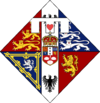
|
Anika, Princess of Amokolia | Three-point label,the centre point bearing a red heart, and an inescutcheon of the coat of arms of Amokolia. |

|
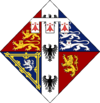
|
Phillipa, Princess Royal | Three-point label,each bearing a red Fourrure héraldique Hermine. |
Currently the following Consorts of the Royal Family have their own arms below:
| Coat of Arms | Shield | Bearer | Difference |
|---|---|---|---|
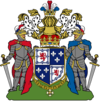
|
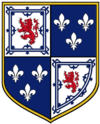
|
Prince Alfred, Duke of Home | Prince Alfred was granted arms of his own in 2010, because men are not entitled to bear the arms of their wives. His arms are quarterly first and fourth rampant lion and double tressure fleury-counter-fleury of Home, representing his dukedom; second and third, Fleur-de-lis, representing his valencian roots. |
Government
Her Majesty's Government uses a version of the Royal Arms but without the helm or crest, as a result of which the crown sits atop the shield. In relation to Amokolia, the Amokolia Office uses the Amokolian version, again without the helm or crest. In relation to Lovely, the Lovely Office uses the Lovelian version, again without the helm or crest. In relation to Valencia, the Valencia Office uses the Valencia version, again without the helm or crest.
The Arms feature on
- All Acts of Law;
- The cover of all Imperial passports; and
- As an inescutcheon on the Diplomatic flags for a Victorian Ambassador
- The High Court
It is also used by the following government departments
- The Amokolia Office (Amokolian version)
- The Foreign Office;
- The Home Office;
- The Lovely Office (Lovelian version)
- The Valencia Office (Valencian version)
- The War Office;
- The Office of the Prime Minister
- The shield of the Royal Arms is used by the Public Records Office;
- The shield of the Royal Arms of Amokolia is used by the Assembly of Amokolia and the Amokolian Public Records Office.
- The shield of the Royal Arms of Lovely is used by the Lovelian Public Records Office.
- The shield of the Royal Arms of Amokolia is used by the Valencian Public Records Office.





